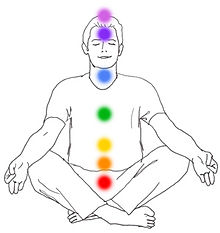
Locations of different Chakras in our body. Each Chakra represted by different color.
Sahasrara: The Crown Chakra

Sahasrara, which means 1000 petalled lotus, is generally considered to be the chakra of pure consciousness, within which there is neither object nor subject. When the female kundalini Shakti energy rises to this point, it unites with the male Shiva energy, and a state of liberatingsamadhi is attained. Symbolized by a lotus with one thousand multi-coloured petals, it is located either at the crown of the head, or above the crown of the head. Sahasrara is represented by the colour white and it involves such issues as inner wisdom and the death of the body.
Its role may be envisioned somewhat similarly to that of the pituitary gland, which secretes hormones to communicate to the rest of the endocrine system and also connects to the central nervous system via the hypothalamus.
Sahasrara's inner aspect deals with the release of karma, physical action with meditation, mental action with universal consciousness and unity, and emotional action with "beingness".
Ajna: The Brow Chakra
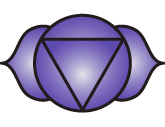
Ajna is symbolized by a lotus with two petals, and corresponds to the colors violet, indigo or deep blue. It is at this point that the two side nadis Ida and Pingala are said to terminate and merge with the central channel Sushumna, signifying the end of duality. The seed syllable for this chakra is the syllable OM, and the presiding deity is Ardhanarishvara, who is a half male, half female Shiva/Shakti. The Shakti goddess of Ajna is called Hakini.
Ajna (along with Bindu), is known as the third eye chakra and is linked to the pineal gland which may inform a model of its envisioning. The pineal gland is a light sensitive gland that produces the hormone melatonin which regulates sleep and waking up. Ajna's key issues involve balancing the higher and lower selves and trusting inner guidance. Ajna's inner aspect relates to the access of intuition. Mentally, Ajna deals with visual consciousness. Emotionally, Ajna deals with clarity on an intuitive level
Vishuddha: The Throat Chakra
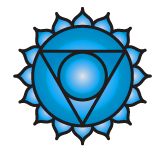

Vishuddha (also Vishuddhi) is depicted as a silver crescent within a white circle, with 16 light or pale blue, or turquoise petals. The seed mantra is Ham, and the residing deity is Panchavaktra shiva, with 5 heads and 4 arms, and the Shakti is Shakini.
Vishuddha may be understood as relating to communication and growth through expression. This chakra is paralleled to the thyroid, a gland that is also in the throat and which produces thyroid hormone, responsible for growth and maturation. Physically, Vishuddha governs communication, emotionally it governs independence, mentally it governs fluent thought, and spiritually, it governs a sense of security.
Anahata: The Heart Chakra
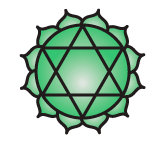
Anahata, or Anahata-puri, or padma-sundara is symbolised by a circular flower with twelve green petals. Within it is a yantra of two intersecting triangles, forming a hexagram, symbolising a union of the male and female. The seed mantra is Yam, the presiding deity is Ishana Rudra Shiva, and the Shakti is Kakini.
Anahata is related to the thymus, located in the chest. The thymus is an element of the immune system as well as being part of the endocrine system. It is the site of maturation of the T cells responsible for fending off disease and may be adversely affected by stress. Anahata is related to the colours green or pink. Key issues involving Anahata involve complex emotions, compassion, tenderness, unconditional love, equilibrium, rejection and well-being. Physically Anahata governs circulation, emotionally it governs unconditional love for the self and others, mentally it governs passion, and spiritually it governs devotion.
Manipura: The Solar Plexus Chakra
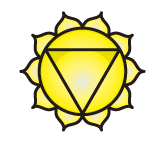
Manipura or manipuraka is symbolized by a downward pointing triangle with ten petals, along with the color yellow. The seed syllable is Ram, and the presiding deity is Braddha Rudra, with Lakini as the Shakti.
Manipura is related to the metabolic and digestive systems. Manipura is believed to correspond to Islets of Langerhans, which are groups of cells in the pancreas, as well as the outer adrenal glands and the adrenal cortex. These play a valuable role in digestion, the conversion of food matter into energy for the body. The colour that corresponds to Manipura is yellow. Key issues governed by Manipura are issues of personal power, fear, anxiety, opinion-formation, introversion, and transition from simple or base emotions to complex. Physically, Manipura governs digestion, mentally it governs personal power, emotionally it governs expansiveness, and spiritually, all matters of growth.
Swadhisthana: The Sacral Chakra
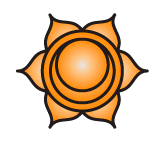
Swadhisthana, Svadisthana or adhishthana is symbolized by a white lotus within which is a crescent moon, with six vermillion, or orange petals. The seed mantra is Vam, and the presiding deity is Brahma, with the Shakti being Rakini ( or Chakini ). The animal associated is the crocodile of Varuna.
The Sacral Chakra is located in the sacrum (hence the name) and is considered to correspond to the testes or the ovaries that produce the various sex hormonesinvolved in the reproductive cycle. Swadisthana is also considered to be related to, more generally, the genitourinary system and the adrenals. The key issues involving Swadisthana are relationships, violence, addictions, basic emotional needs, and pleasure. Physically, Swadisthana governs reproduction, mentally it governs creativity, emotionally it governs joy, and spiritually it governs enthusiasm.
Muladhara: The Root Chakra
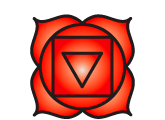
Muladhara or root chakra is symbolized by a lotus with four petals and the color red. This center is located at the base of the spine in the coccygeal region. It is said to relate to the gonads and the adrenal medulla, responsible for the fight-or-flight response when survival is under threat.
Muladhara is related to instinct, security, survival and also to basic human potentiality. Physically, Muladhara governs sexuality, mentally it governs stability, emotionally it governs sensuality, and spiritually it governs a sense of security. Muladhara has a relation to the sense of smell. This chakra is where the three main nadis separate and begin their upward movement. Dormant Kundalini rests here, wrapped three and a half times around the black Svayambhu linga, the lowest of three obstructions to her full rising (also known as knots or granthis).
The seed syllable is Lam (pronounced lum), the deity is Ganesh, and the Shakti is Dakini. The associated animal is the elephant.


